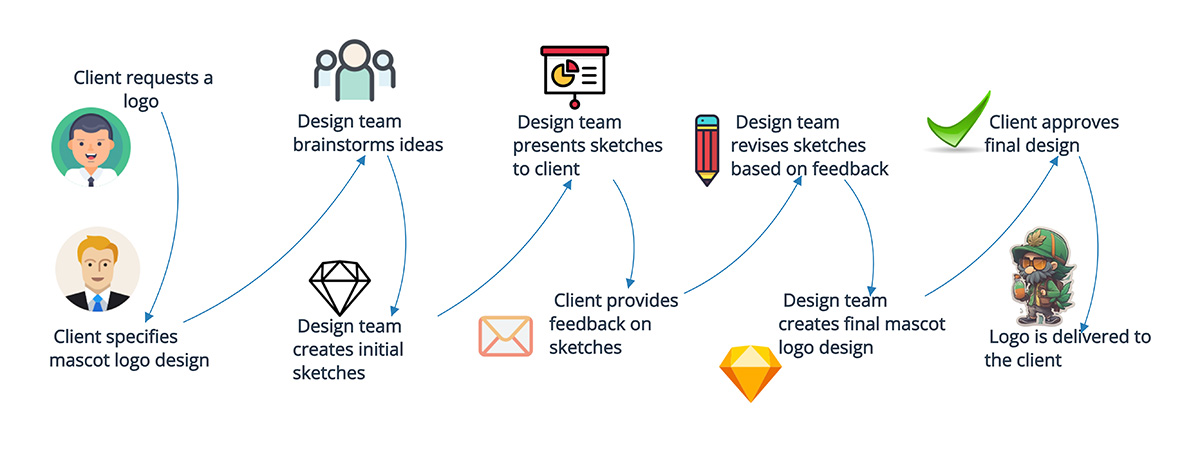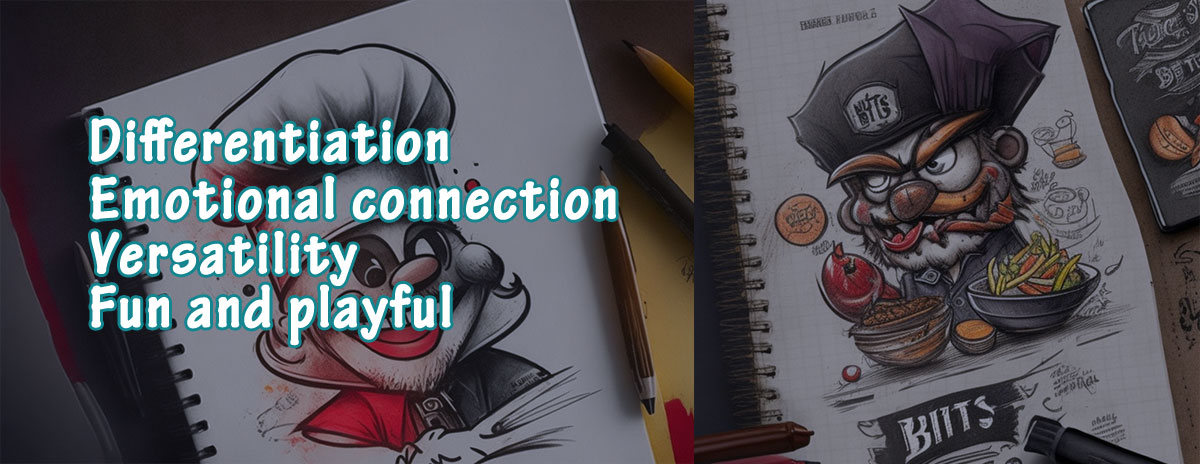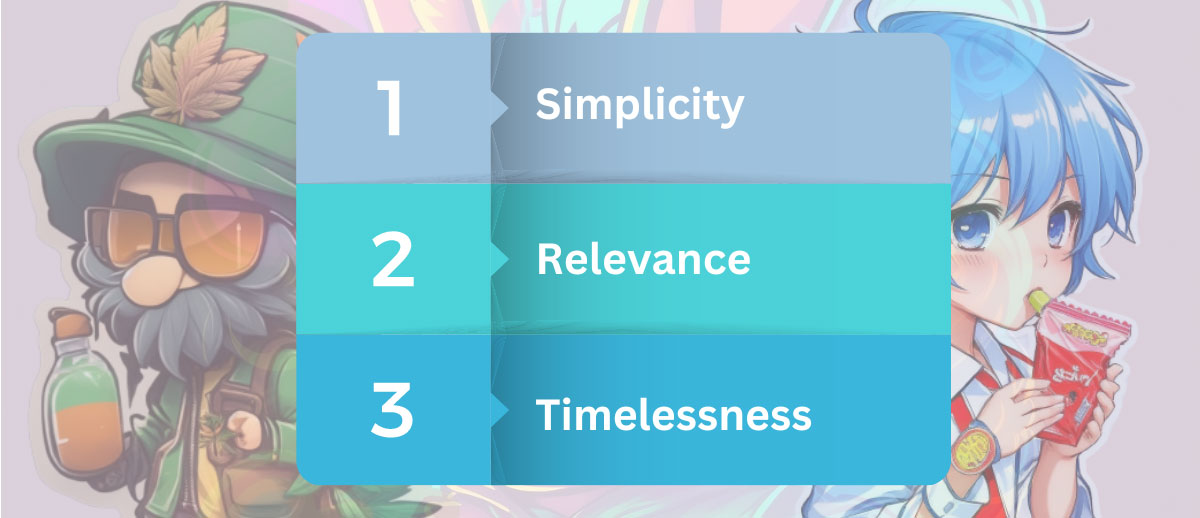Custom Mascot Logo Design Service | Expert Tips & Build Brands
Are you looking for a way to create a visual identity for your brand or business that stands out from the competition? Look no further than a custom mascot logo design! A well-designed mascot logo can help establish brand recognition, differentiate your business, and create an emotional connection with your customers.
In this blog post, we’ll delve into the world of mascot logo design and provide expert tips for building a strong brand identity. We’ll cover topics such as what a mascot logo design is, how to design one, what makes a good mascot design, and the different types of mascot design. We’ll also discuss the purpose of a brand mascot, whether mascot logos are a good idea, and how to trademark a mascot logo.
So, whether you’re a small business owner, entrepreneur, startup, or large company, read on to discover how a custom mascot logo can help build your brand and set you apart from the competition.

What is a Mascot Logo Design?
A mascot logo design is a type of logo that features a character or figure as the central element. The mascot can be a person, animal, or object, and is generally designed to represent the brand or business it is associated with. Mascot logos often have a playful and whimsical feel and can be used to create an emotional connection with customers.
A good mascot logo design will incorporate a few key elements. Firstly, the mascot character should be unique and memorable, with a strong personality that reflects the brand’s values and messaging. Secondly, the typography used in the logo should complement the mascot character and be easy to read. Finally, the color scheme used should be consistent with the brand’s overall visual identity and be appealing to the target audience.
Mascot logos are often used in a variety of marketing materials, including business cards, websites, social media profiles, and advertisements. They can help establish brand recognition and differentiate a business from its competitors.
If you’re interested in creating a mascot logo for your brand or business, there are a variety of options available. You can create a mascot logo online using a mascot logo editor or hire a professional mascot logo design service to create a custom mascot logo that meets your specific needs.
How to Design a Mascot Logo?
Designing a mascot logo can be a fun and creative process, but it can also be challenging to create a design that effectively represents your brand or business. Here are some tips to help you design a mascot logo that will make your brand stand out:
- Understand your brand: Before you start designing your mascot logo, it’s important to have a clear understanding of your brand identity and messaging. Consider your brand’s values, target audience, and overall visual identity.
- Choose the right mascot character: The mascot character you choose should be unique and memorable, with a strong personality that reflects your brand’s values and messaging. Consider the characteristics and traits that you want your brand to embody and choose a mascot character that aligns with those traits.
- Typography: The typography used in your mascot logo should complement the mascot character and be easy to read. Consider using bold and clear fonts that will stand out and be easily recognizable.
- Color scheme: The color scheme used in your mascot logo should be consistent with your brand’s overall visual identity and be appealing to your target audience. Use colors that resonate with your audience and evoke the desired emotions.
- Test and refine: Once you have a draft of your mascot logo, test it out with your target audience to get feedback and make any necessary refinements. A good mascot logo design should be memorable, unique, and resonate with your target audience.
You can create a mascot logo online using a mascot logo maker or hire a professional mascot logo designer to create a custom mascot logo that meets your specific needs.
What Makes a Good Mascot Design?

A good mascot design is essential for creating a memorable and effective mascot logo. Here are some key elements that make a good mascot design:
- Uniqueness: A good mascot design should be unique and stand out from other mascots in the same industry or niche. It should be easily recognizable and distinct from other brands.
- Simplicity: A good mascot design should be simple and easy to understand. It should be easily recognizable and memorable by your target audience.
- Relevance: A good mascot design should be relevant to your brand or business. It should reflect the values, personality, and messaging of your brand.
- Versatility: A good mascot design should be versatile and adaptable to different mediums and applications. It should be able to be used in a variety of marketing materials, from websites to social media profiles to business cards.
- Appeal: A good mascot design should be appealing to your target audience. It should evoke the desired emotions and resonate with your audience.
By incorporating these elements into your mascot design, you can create a memorable and effective mascot logo that will help establish brand recognition and differentiation.
What is a Brand Mascot Strategy?
A brand mascot strategy is a marketing approach that uses a mascot character to represent a brand or business. The mascot character is designed to embody the brand’s values, personality, and messaging, and is used to create an emotional connection with customers.
A brand mascot strategy can be an effective way to build brand recognition and loyalty. By incorporating a mascot character into your branding efforts, you can create a unique and memorable visual identity that sets you apart from your competitors.
To develop a brand mascot strategy, it’s important to consider your target audience, brand values, and messaging. Your mascot character should align with your brand identity and be easily recognizable by your target audience. The mascot should also be versatile and adaptable to different marketing materials and campaigns.
A brand mascot strategy can be implemented in a variety of marketing materials, including advertisements, social media profiles, packaging, and websites. By using a brand mascot consistently across different channels, you can create a strong and cohesive brand identity that resonates with your audience.
Types of Mascot Design
Mascot designs can take many forms, with different types of mascot characters used to represent a brand or business. Here are some of the most common types of mascot designs:
- Animal mascots: Animal mascots are a popular choice for brands and businesses, as they can be easily recognizable and evoke specific emotions and characteristics associated with the animal. Examples of animal mascots include the Geico gecko and Tony the Tiger.
- Human mascots: Human mascots are another common type of mascot design. They can be used to represent specific professions, such as the Jolly Green Giant, or to embody certain characteristics, such as the Energizer Bunny.
- Object mascots: Object mascots are mascots that are designed to represent a specific object or product. Examples include the Michelin Man and the Pillsbury Doughboy.
- Hybrid mascots: Hybrid mascots are mascot designs that combine multiple elements, such as animal and human characteristics, to create a unique and memorable character. Examples include the KFC Colonel and the Planter’s Peanut Man.
When choosing a mascot design for your brand or business, it’s important to consider your target audience and brand identity. The mascot character you choose should be relevant to your brand and resonate with your audience.
The Purpose of a Brand Mascot
The purpose of a brand mascot is to create a visual representation of a brand or business that can be easily recognized and remembered by customers. A well-designed mascot can help establish brand recognition, differentiate a business from its competitors, and create an emotional connection with customers.
Mascots can also be used to convey specific messages or values associated with a brand. For example, the Michelin Man mascot is designed to represent durability and strength, while the Green Giant mascot embodies health and nutrition.
Brand mascots can be used in a variety of marketing materials, including advertisements, social media profiles, packaging, and websites. They can help create a strong and cohesive brand identity that resonates with customers and builds brand loyalty.
In addition to their marketing benefits, brand mascots can also be used to create a sense of fun and playfulness around a brand. This can help create a positive association with the brand and make it more memorable in the minds of customers.
Are Mascot Logos Good?

Mascot logos can be a great option for businesses looking to create a strong and memorable visual identity. Here are some reasons why mascot logos can be a good choice:
- Differentiation: A well-designed mascot logo can help differentiate your business from its competitors. By creating a unique and memorable character, you can stand out in a crowded market and establish brand recognition.
- Emotional connection: Mascot logos can help create an emotional connection with customers by evoking specific emotions and characteristics associated with the mascot character. This can help build brand loyalty and make your brand more memorable.
- Versatility: Mascot logos can be used in a variety of marketing materials, from business cards to websites to social media profiles. This versatility makes them a great option for businesses looking for a flexible branding solution.
- Fun and playful: Mascot logos can add a sense of fun and playfulness to your branding efforts, making your brand more approachable and appealing to customers.
However, it’s important to note that mascot logos may not be the best choice for every business. It’s important to consider your target audience, brand identity, and industry when deciding on a branding strategy. Some industries, such as law or finance, may not lend themselves well to a playful mascot logo.
Ultimately, the decision to use a mascot logo should be based on your specific business needs and goals.
Can I Trademark a Mascot?
Yes, it is possible to trademark a mascot character. Trademarking your mascot can help protect your brand identity and prevent others from using a similar mascot for their own branding efforts.
To trademark a mascot, you will need to follow the standard trademark registration process. This involves conducting a trademark search to ensure that your mascot is not already in use by another business, submitting a trademark application with the appropriate government agency, and paying the required fees.
When trademarking a mascot, it’s important to ensure that the mascot design is unique and distinctive. This can help prevent others from creating a similar mascot that may cause confusion with your brand.
It’s also important to note that trademark protection only applies to the specific goods and services listed in your trademark application. If you plan to use your mascot for multiple products or services, you will need to submit a trademark application for each one.
Overall, trademarking your mascot can be a valuable way to protect your brand identity and establish ownership over your mascot character.
The 3 Rules of Good Logo Design

Designing a good logo is essential for creating a strong and effective brand identity. Here are the three rules of good logo design:
- Simplicity: A good logo should be simple and easy to understand. It should be easily recognizable and memorable by your target audience. A simple logo design can also be more versatile and adaptable to different marketing materials and applications.
- Relevance: A good logo should be relevant to your brand or business. It should reflect the values, personality, and messaging of your brand. The logo design should be able to convey a clear message about your brand and what it stands for.
- Timelessness: A good logo should be timeless and able to withstand the test of time. It should not be trendy or too focused on current design trends that may quickly become outdated. A timeless logo design can help establish brand recognition and longevity.
By following these three rules of good logo design, you can create a memorable and effective logo that will help establish brand recognition and differentiation.
Conclusion
In conclusion, mascot logos can be a great option for businesses looking to create a strong and memorable visual identity. A well-designed mascot can help establish brand recognition, differentiate a business from its competitors, and create an emotional connection with customers.
When designing a mascot logo, it’s important to consider the key elements of good mascot design, such as uniqueness, simplicity, relevance, versatility, and appeal. By incorporating these elements into your mascot design, you can create a memorable and effective mascot logo that will help establish brand recognition and differentiation.
It’s also important to consider the purpose of a brand mascot and how it can be used in a brand mascot strategy to create a strong and cohesive brand identity. A well-designed brand mascot can help build brand recognition and loyalty, while also adding a sense of fun and playfulness to your branding efforts.
When designing a logo, whether it’s a mascot logo or a traditional logo, it’s important to follow the three rules of good logo design: simplicity, relevance, and timelessness. By following these principles, you can create a logo that is easily recognizable, relevant to your brand, and able to withstand the test of time.
Overall, mascot logos can be a valuable tool in building a strong and effective brand identity. By carefully considering your target audience, brand values, and messaging, you can create a mascot logo that resonates with your audience and helps establish your brand as a leader in your industry.